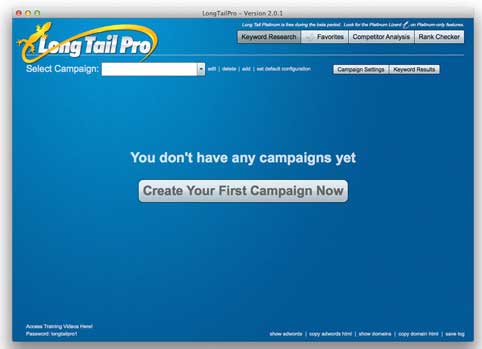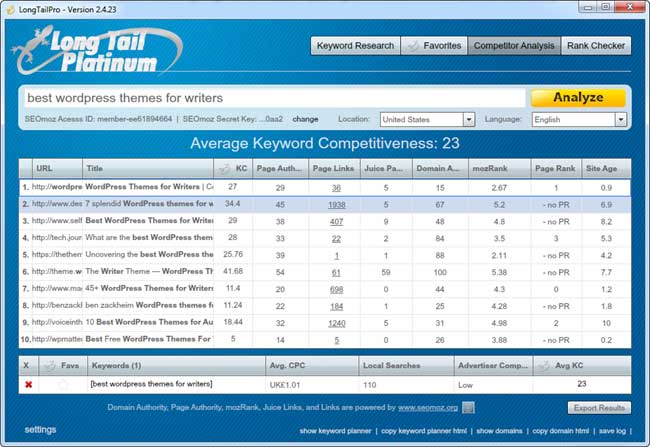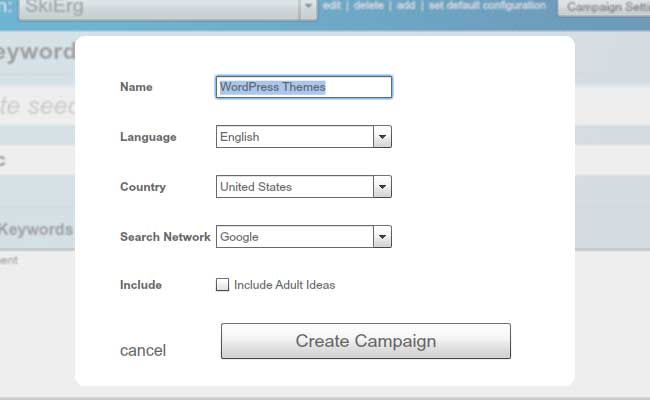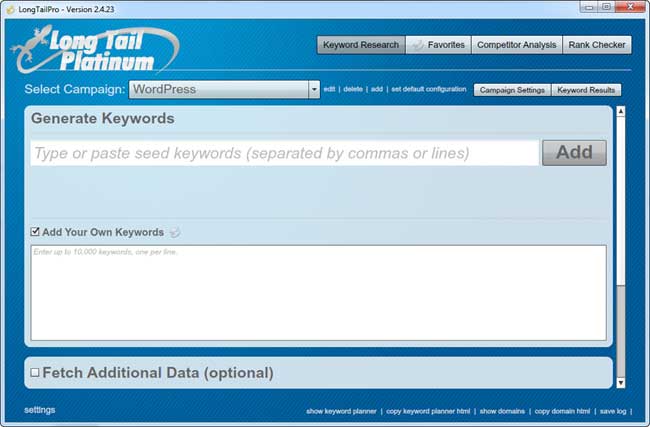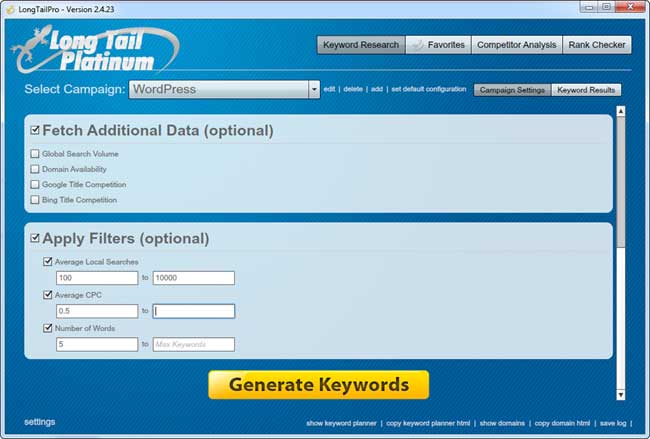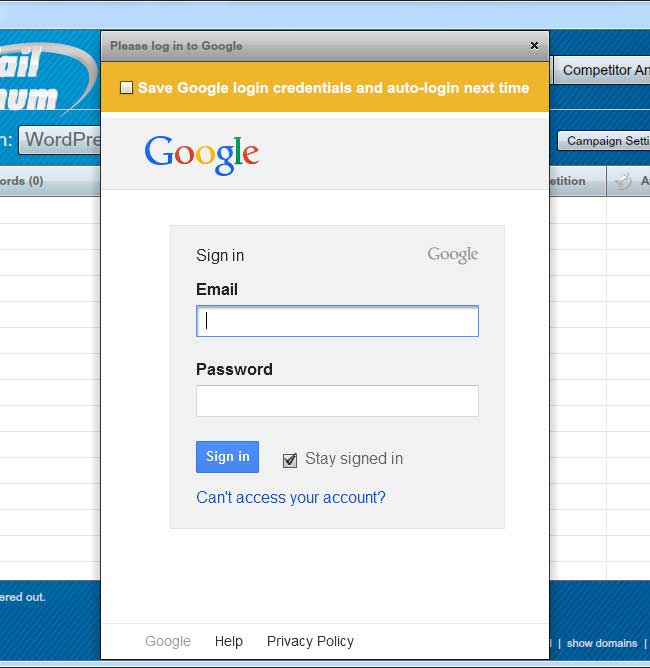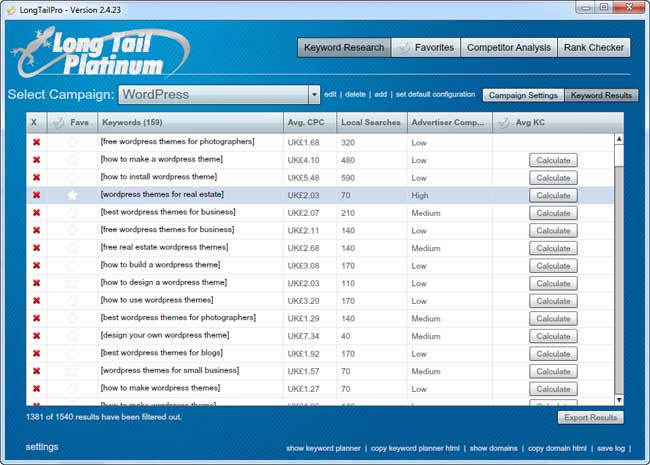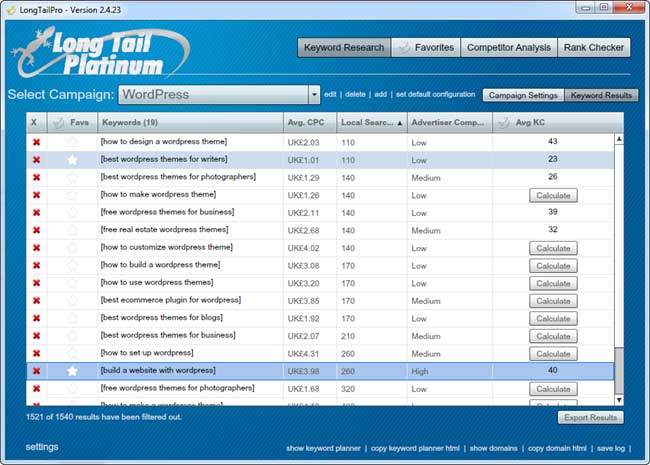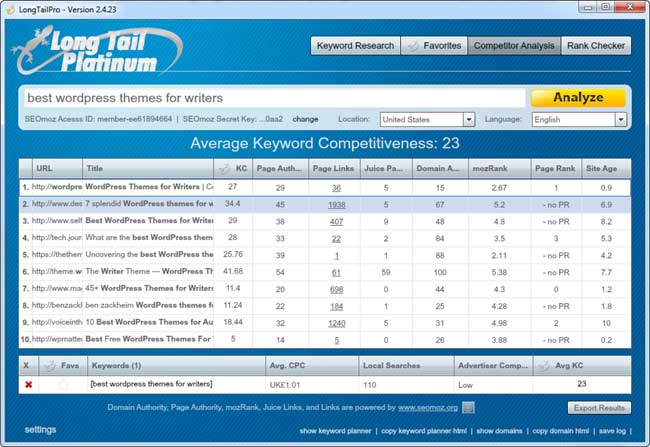Long Tail Pro is a keyword research tool that allows you to easily see which words, terms or phrases people are searching the internet for. Being able to know which keywords are being searched, and in what volume, allows you to ensure there is an audience for your content before you write it. This makes a keyword research application a valuable tool to have at your disposal when it comes to publishing content online in any form.
While there are many tools of this type available, Long Tail Pro and the Platinum upgrade have a number of features which aim to set them apart from the competition and make your keyword research more effective and more efficient. One feature in particular is its impressive ability to analyse the competition for a keyword. This will help you quickly decide if you would have a chance of getting your content listed in the search engines where people can find it (or not).
Today we are going to be taking a look at Long Tail Pro and the premium Platinum version to find out if it really is worth your time and money. In this Long Tail Pro review, we will also cover the main differences between the two versions, as well as giving you a quick start guide to using the software.
Why Research Keywords?
Whatever your reason for publishing content online, it’s important to know if there are people interested in the topics you are writing about. If no one is using search engines to find information about a particular topic or keyword, writing an article focused on that subject is unlikely to result in any visitors finding their way to your site.
While it’s always preferable to write about topics you are interested in, and not be dictated to by how popular a certain topic is, it can be a frustrating experience if your epic post on the sleeping patterns of Malaysian freshwater toads never results in a single visitor to your site.
Using a keyword research tool can not only help you find topics to write about which have an existing audience, but it can help you tweak your content ideas to make them more likely to result in visitors to your site. For example, by slightly modifying a post title to match a popular keyword, you could find that particular page generating more visitors from the search engines due to it ranking more prominently, thanks to the lower competition and higher search volumes that keyword receives. By using a tool like Long Tail Pro you can make finding those keywords much less of a challenge.
Who is this Tool for?
Long Tail Pro has been created to help affiliate marketers and niche site builders make money online by finding profitable keywords and niches that have low competition. However, anyone who is publishing content online with the aim of getting visitors from the search engines like Google, can benefit from using this tool.
Some of the types of websites and online publishers that can benefit from a keyword research tool include:
- Bloggers
- Online Store Owners
- Affiliate Marketers
- Websites Monetised with AdSense
- Niche Site Builders
- Content Marketers
- SEOs
If you are publishing content online with the intention of getting free traffic from search engines, a keyword research tool like Long Tail Pro can really help you out.
Features of Long Tail Pro and Platinum
While the number of people searching for a particular keyword each month can be found out for free using the Google Keyword Planner tool, Long Tail Pro has a number of additional features that have helped it become one of the most popular applications for keyword research today.
We will cover the features in more detail when we get to the hands-on review of Long Tail Pro, but here are some of the highlights of this software:
- Generate additional keywords based on your source or seed keyword
- Filter keywords based in a number of criteria
- View the monthly local and global search volumes for those keywords
- See the cost per click (CPC) paid by advertisers for those keywords
- View the top 10 ranking sites for a keyword
- Discover various SEO ranking metrics for each top 10 site
- Generate an overall competitiveness score for the top sites so you can quickly evaluate a keyword
- Save individual keywords to a favourites list and export to Excel
- Track the rank of your site in the search engines
As you can see, this software not only tells you how many people are searching for a particular keyword or term each month, it also shows what sites are already ranked in the top 10 for that keyword and how tough they might be to compete with for the top spot in Google. The information for those top 10 sites includes a range of metrics including the number of backlinks, domain authority, page rank, and site age.
Armed with this information, you can quickly create a shortlist of keywords that are being searched for on a regular basis each month, and have limited competition in the top 10 search results in Google. With this additional information you can start publishing content that will stand a good chance of being featured on page one in Google, resulting in a steady stream of visitors to your website.
By taking the guesswork out of the content generation process for your site, you can use your time more effectively and in ways that will result in more traffic to your site, which you can then convert to subscribers, customers or clients.
Long Tail Pro vs. Long Tail Platinum
While Long Tail Pro is available for a one-off payment of $97, Long Tail Platinum is an upgrade to the Pro version and requires a monthly subscription in order to access the advanced features. After purchasing the Pro version you can upgrade or downgrade at any time, simply by subscribing and activating a recurring monthly payment through PayPal.
The main selling point of the Platinum version is the ability instantly get a keyword competitiveness score, known as KC (keyword competitiveness). This figure is generated by analysing the top sites listed in Google for a particular keyword. As this data is sourced from a range of services, each with their own costs, the developers of Long Tail Pro have therefore decided to charge a monthly fee for access to the Platinum version and the KC rating.
At the time of writing, the monthly fee for access to the Platinum version is $17. If you are considering using this tool then I would strongly recommend you factor in this monthly cost when making a decision, as the Platinum features are pretty much essential if you want to really speed up and improve your keyword researching abilities.
With the Pro version you can still view the top 10 ranking sites for each keyword, and view the various data about them, but you don’t get the overall KC score. This means you have to analyse those top 10 sites and make a judgement on how competitive they are and whether your site can compete with them or not. With the KC feature, you can simply click on a button and then view the score without having to load up and view the top 10 sites.
While the KC score shouldn’t be relied on entirely, it does allow you to quickly whittle down the results and see the less competitive keywords which can then be manually inspected in more detail.
How to Use Long Tail Pro
Long Tail Pro makes use of campaigns to organise the different searches you perform. You can create multiple campaigns and each one can have its own settings. When you create a new campaign the options allow you to choose a language, a country (geographical version of Google), and whether to search just Google, or Google and search partners.
To start using the software to generate keywords and view the data, you have two options, and both can be used together:
- Enter up to 10 seed keywords
- Add your own keywords (up to 10,000)
Seed keywords are used to query Google and then gather related search terms. For example if you entered ‘WordPress themes’ as a seed keyword you would get a long list of related keywords such as ‘WordPress plugins’, free WordPress themes’ and so on.
By entering your own keywords, the software won’t use those keywords to generate other related keywords and will only research the ones you enter. This is a handy feature as it allows you to use other keyword suggestion tools such as Fresh Key and then paste those keywords into Long Tail Pro for further analysis.
Before generating keywords, you can opt to fetch some additional data about them. By default the software will collect the local search volume and the cost per click, but you can also gather additional data such as:
- Global Search Volume
- Domain Availability
- Google Title Competition
- Bing Title Competition
The domain availability data searches for domains that match the keywords you are researching. If you are yet to develop your website, this data can be helpful when it comes to finding a domain, as it will show any domains that are available to register that match any of your keywords. If you are hoping to take advantage of the slight ranking boost exact match domains receive from Google, then you will love this feature.
The Google and Bing Title Completion data is pretty worthless, especially when compared to the much more valuable KC score that is available with the Platinum version.
The next step allows you to define filters to ensure that the results are more relevant. These filters include:
- Average Local Searches
- Average CPC
- Number of Words
The first filter will only show keywords with a certain number of searches per month. This is good for eliminating keywords that might get no results or only a few searches a month.
Average CPC refers to the amount of money advertisers using Google Adwords will pay Google to display an advert targeting that keyword. This can give you an indication of how much you will earn each time someone clicks on an AdSense advert displayed on your site for that keyword.
As this tool is focused on helping you find long tail keywords with little completion, it’s a good idea to use the number of words filter to eliminate one or two word keywords in an attempt to find some longer tail and less competitive keywords where you will stand a better chance of ranking your site in the top 10 in Google. Depending on how many words are in your seed keyword, you could filter all keywords with three words or less.
The next step is to click on the ‘Generate Keywords’ button and sit back and let the software do its job. The number of seed keywords you’ve entered or your own keywords you’ve provided will affect the amount of time it takes to complete the task, but it’s not an overly long process.
If this is the first time you’ve run the software, you will be prompted to login to your Google account so the tool can access the Keyword Planner service.
Once the results have been generated, you can go back and adjust the filters simply by clicking on the ‘Campaign Settings’ button.
Analysing the Results
Once the keyword generation process has run, the keywords and the data you chose to collect will be displayed.
At the bottom left hand corner of the screen you can see how many results have been returned, and how many have been filtered out. If you want to see more or less results, click on the ‘Campaign Settings’ button to readjust the filters.
All the columns can be sorted by clicking on their titles. It’s a good idea to sort on ‘Local Searches’ to view the keywords by their popularity.
If you are looking for keywords to use in a blog post, picking a handful of related keywords that get between 100 and 500 local searches can be a good idea, depending on their keyword (not Advertiser) competition. If you can rank your article well for those related keywords then you will see a few extra daily visitors to your site, by the time you’ve added multiple pages focused on other keywords you can quickly grow the number of visitors your site receives from Google.
Obviously, the more searches a keyword gets a month the better, but this usually means it will be harder to rank for those keywords due to all the other sites trying to rank for those keywords too. However, if you are lucky enough to find a keyword that gets 1000s of local monthly searches and has little competition then you could see your traffic grow significantly.
So while you should always be looking for those high volume, low competition keywords, if you can’t find any just yet, don’t use that as an excuse to not do anything but instead start focusing on the low volume, low competition keywords for now. The more pages your site has, and the more keywords it targets, the more traffic it will eventually receive.
How to Analyse the Competition
Analysing the competition for a particular keyword is the hardest part of keyword research and although Long Tail Pro and the Platinum version especially makes it much easier, there is still some work that needs to be done. Your competition evaluation skills will develop over time, but by using this software you can increase your chances of picking a keyword that is easy to rank your site for.
If you are using the Platinum version, you can just click on the ‘Calculate’ button in the Avg KC column for any keywords that appeal to you. Once the results are returned you can immediately eliminate any of the high competition keywords you stand little chance of ranking for with a new site.
Anything with a KC score of 30 or less is worth investigating, while those with a higher score are probably going to be too hard to rank for unless your site is already well established with lots of positive metrics such as domain authority, page rank, and trust flow.
If you spot any keywords with low KC scores, you can then click on the keyword or the KC score to view the top 10 sites already ranking for that keyword. If you don’t have the Platinum version then you will have to just click on the keyword and then take a look at the top 10 for each keyword which can be very time consuming.
From the above example, we can see that one of the keywords that was generated has an average KC of 23, which looks promising. If we click on that keyword we can see all the websites ranking for the ‘best wordpress themes for writers‘ keyword and some relevant data about them.
As you can see, the software tells you the KC rating for each individual site, giving you an idea of how competitive those sites are. In the ‘best WordPress themes for writers‘ example, there are some sites with a very low KC rating which probably wouldn’t be hard to out rank with a well optimised article and some good internal linking.
By evaluating the data for each site in the top 10 for the keywords that interest you, you can get a fuller picture of just how easy or hard it will be to rank your content for that particular keyword. So although the KC score is a great indicator of how hard a keyword will be to rank for, it is still recommended that you take a look at those top 10 sites to see where the weak sites are ranked and whether you think you can out rank them.
Once you’ve found some suitable keywords, you can then favourite them to add them to your shortlist, or export the whole set to a CSV file and then work with them in Excel.
You can manually inspect the top 10 sites for each keyword in the regular version of the software and get some great data on them, such as number of backlinks, page rank and site age. However, without the average KC score from the Platinum version, your job will take a lot longer. Without being able to quickly eliminate the highly competitive keywords before creating the list of results you want to investigate further you will have a lot more top 10s to evaluate.
The Downsides
While Long Tail Pro and Platinum have lots of great features, and really do increase your chances of finding rankable keywords to generate traffic from, it’s not without its quirks.
Despite being much faster than the competition, including Market Samurai (the most popular keyword research tool a few years ago), Long Tail Pro can be a bit slow at times. However, if you take into consideration all the different data sources that are queried to generate the results, you begin to understand why this is the case.
As the software connects to the Google Keyword Planner and scrapes that service to get some of its data, such as the number of times a keyword is searched for locally and globally, you can get your IP address temporarily banned from Google from time to time. This isn’t as serious as it sounds, but it does mean you can’t use the software for a while until the ban is lifted. This tends to be minutes and hours rather than days, and it not a very common occurrence, although it does happen if you are really hammering it and researching 1000s of keywords at time.
Occasionally the software will get a bit stuck and require you to exit and restart it. Sometimes it will be necessary to delete a campaign and then re-create it to help Long Tail Pro get back on track. However, the support team that look after the software respond to email tickets very quickly should you need to contact them.
While all the above might sound like they disrupt the user experience significantly, this isn’t the case, and nine times out of ten the software works really well.
Conclusion and Recommendations
If you are building niche sites monetised with AdSense or affiliate offers, or you just want to ensure you are writing your blog posts on topics people are actually searching for, Long Tail Pro is a highly recommended research tool.
As it brings in data from lots of sources, and gives you an easy way to quickly evaluate thousands of keywords at a time, it really is a must for anyone hoping to receive visitors to their site via search engines.
The tool is very easy to use, and while not as feature packed as something like Market Samurai, it does the important jobs much better and is, overall, a much more efficient tool.
While the temporary Google IP banning problems can be few and far between, it would be nice if the software supported proxies, just to give you that bit of extra protection. A mobile version would be great too for killing time when you are away from the computer and have an opportunity to do a bit of research.
Overall, Long Tail Pro, and in particular the Platinum upgrade, come highly recommended. It will help anyone who publishes content online, especially those who want to receive as much search engine traffic as possible.
A copy of Long Tail Pro will cost you $97; with the platinum tools costing an additional $17 per month.
There is no need to take a risk on Long Tail Pro as there is free trial available that lets you use it for ten days. I recommend doing that before clicking the buy button. That will give you enough time to see whether Long Tail Pro does what you need.
Thanks,
Joe



